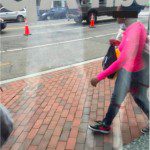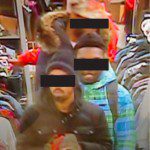Critics Claim Racial Bias in Georgetown Digital Crime Prevention
By • October 17, 2015 0 5480

A special investigative report on technology and profiling in Georgetown.
The rapid recent pace of technological innovation has triggered a new era of policing, one in which crime fighting is based almost entirely on data — captured, analyzed and communicated using the latest digital tools.
Last year, the Georgetown Business Improvement District began using the Microsoft-owned mass-messaging application GroupMe to bolster communication between local businesses and Metropolitan Police Department officers. As John Wiebenson, the BID’s operations director, noted, “Criminals move so quickly, we needed real-time communication.”
MPD Officer Antonial Atkins spearheaded the effort on the police side, glad to replace an endless stream of text messages from merchants and Georgetown citizens with a single, centralized messaging app. Yet Atkins — MPD Officer of the Year in 2013 — was quick to point out that GroupMe “is not a police app,” although he’s proud to call it “my idea.”
The results of that idea, cataloged in more than a thousand messages on the app beginning in March 2014, show a vigilant community working to identify threats and prevent crime. However, the posts as a whole also illustrate a stark racial disparity in how crime and suspicious behavior are reported in the community, raising hard questions about the relationship between community policing and civil rights.
Racial Bias on GroupMe
Most striking within the app is the frequency with which African Americans are reported for criminal and suspicious behavior. Of 330 people described in messages warning of suspicious or criminal activity posted between March 1, 2015, and July 5, 2015, 236 — or 72 percent — are identified as African Americans (often aa on the app).
Data about the percentage of African Americans among Georgetown shoppers is not available, but — given that only a quarter of the residents of the Washington metropolitan area are black or African American (2010 U.S. Census and 2011 American Community Survey) — it is likely to be much smaller than 72 percent. By way of comparison, GroupMe users in Georgetown flagged only 16 white people, less than half of 1 percent of the total, for committing some sort of crime or business disruption.
With regard to pictures distributed on GroupMe of suspects and “suspicious” characters over the study period, 19 photos of African Americans were circulated to the group, while only one photo of a white person was posted. Seventy-six people mentioned in the chat were not identified by race, while the group reported one Hispanic and one Asian man as suspicious.
“A racial bias is pretty apparent based just on the pictures and descriptions [in GroupMe],” says a Levi’s employee who wishes to remain anonymous. Isabel Savage at Hu’s Wear called certain posts on the app “racism at its greatest form,” adding, “the [retail] industry breeds it.”
Savage’s coworker at Hu’s Wear, Hannah Warren, initially agreed with Savage’s representation of racial bias on the Georgetown GroupMe account. But after being confronted with examples of posts labeling black men as suspicious without evidence, Warren explained that one of the men in question “was dismissive,” “standing very close to the racks” and “had a hat pulled down low.” “Better safe than sorry,” she said, before admitting, “a little bit of profiling, I do it.”
Based on The Georgetowner’s interviews with managers and messages on GroupMe, users here have a wide range of triggers when it comes to suspicion. Multiple GroupMe users in Georgetown said that one indication that a customer is likely to shoplift is the carrying of heavy or old bags. (H&M bags are particularly suspicious, according to interviews with store managers).
Sometimes users flag people as “suspicious” without giving a reason, noting “no confirmed theft.” Certain clothes and hairstyles can trip the alarm for a store employee and lead to a GroupMe message. People with dreadlocks, or “dreads,” are often flagged as “suspicious.”
Speaking off the cuff, Atkins, a middle-aged African American man, mentioned that a shopkeeper told him that without his uniform he could look like a shoplifter who was in the store last week.
While Atkins expressed concern over the racial disparities exhibited in GroupMe, he said that by and large he trusts the app’s users to call it like they see it without bias, in part because their posts “will be there for life.”
Joe Sternlieb, the president and CEO of Georgetown BID, offered a similar response. “The underlying assumption here is that people [GroupMe users] know what suspicious behavior is and they just report what they see,” he said, adding, “a lot of security officers at the stores are African American.” (D.C.-based lawyer and ethicist Jack Marshall used the black police officers in Baltimore that arrested Freddie Gray, who died in police custody, as an example that bias can affect anyone.) “It’s not like a law enforcement agency is targeting a specific group of people,” Sternlieb said.
According to statistics provided by MPD, theft is down 10 percent and crime overall is down 7.5 percent compared with year-to-date figures within the BID’s jurisdiction from last year. Atkins attributed those drops to “people getting involved” through GroupMe. When police do catch someone, users celebrate, writing messages like “I love this app” or congratulating police with “Good job!” He said that people thank police in Georgetown for their services, with waves on the street or messages on the app. Officers are “very happy” with how they’re treated by Georgetowners.
The Beginning
The BID, a nonprofit funded by a tax on property owners within its boundaries, launched the app, branding the new group “Georgetown Business Public Safety: Keeping Georgetown Safe,” in GroupMe. At first, most messages came from police officers, including Atkins, notifying store managers about things to look out for, such as thieves, protests and bad weather.
As use has expanded, more and more messages have come from store managers and other employees, reporting crimes to the police and warning one another about criminals in the area. Atkins estimated that, currently, 85 percent of messages “come from the stores.” The group count at press time is 340 people, including 30 police officers.
When downloaded on a phone (or, less often, a computer), the app allows users to communicate instantly with all the members of their particular group. Messages, which can include photos and other media, appear on users’ home screens instantly. All users then have a chance to respond to the entire group.
Almost every store in Georgetown has one or more employees on GroupMe, but the heaviest users are managers and loss-prevention employees at national retail outlets such as Zara, TJ Maxx, Levi’s, CVS, American Apparel, Abercrombie & Fitch, Dean & Deluca, All Saints, Banana Republic and Cusp.
Reviews Are In
When asked about the app, managers using it gave mostly positive reviews. Just after chiding a few employees for not joining the group, Brian Edmondson, manager of Sports Zone and a 14-year retail veteran, told The Georgetowner, “Shoplifting is a problem you can’t do much about because the penalties really aren’t that high.” He said GroupMe has helped prevent theft at Sports Zone by identifying known thieves in the area.
Similarly, Alex and Ani assistant manager Gaelle Taku said, “GroupMe is very helpful when shoplifters are headed our way.” A manager at Barbour said the app was “good for organized crime,” referring to group theft and flash mobs (not Tony Soprano’s crowd). A number of employees praised Officer Atkins and his involvement in GroupMe.
Other users gave the app mixed reviews. “[GroupMe] is helpful but I honestly stopped using it because it was just too much,” a manager at American Apparel said. Jillian Berman at Banana Republic concurred. “I had to get off it,” she said, despite it being a helpful communication tool, because she was receiving too many messages on her phone.
Paul Collins, a manager at Rag & Bone, called the app “hit or miss” in terms of getting a police response, and said he thought some users were “too quick” to report people for trivial, non-criminal things — smelling like marijuana, for instance. The Barbour manager said he had to take posts like that “with a grain of salt.”
Rules and Results
That’s not what users are supposed to be posting, according to BID officials. A closed group, “users have to be invited, they have to have a conversation with John [Wiebenson] about the rules,” Georgetown BID president and CEO Joe Sternlieb said. He explained that GroupMe is used “exclusively to report possible criminal activity and known criminals.” As for rules, both BID officials said that merchants are instructed to call 911 before reporting crime on GroupMe. Of particular importance, Sternlieb noted, is that users describe, “where they went, what they look like and what they’re wearing,” with regard to suspects.
In the process of writing hundreds of posts with these details, GroupMe users in Georgetown have developed a coded, text-friendly and abbreviation-heavy dialect. For example, “BOLO” means be on the look out, and is usually accompanied by a description of a crime or a known thief, or a suspicious activity such as carrying old bags or ignoring staff. Often, GroupMe users send out photos taken on security cameras or smartphones of known criminals or people acting suspiciously.
Stores frequently ask officers to perform a “walk thru” to scare off anyone suspicious, and police usually respond “omw” for “on my way.” (If an officer isn’t available, he or she will message back telling the user to call 911.)
Certain behaviors, like being quiet or curt, or looking over to the counter, are deemed suspicious in GroupMe. Walking around at too fast or too slow a pace is an alarm for other employees. Being part of a large group, especially of young people, can also lead to someone raising a flag on the app.
Occasionally, officers make arrests, but Atkins says part of the purpose of GroupMe is to prevent crime. More often though, GroupMe users get it wrong. In most cases, this ends with little fanfare and no mention on the message board.
Here are a few examples:
At the beginning of March, “American Apparel (3025 M St NW) Ayesha Mgr” posted, “3 African american girls, one with curly red dreds, other has bangs and shoulder length hair, and the other.” The text breaks off and Officer DeRuvo responds, “Omw. Walking,” before Ayesha finishes the sentence with “acting suspicious…” The girls return later, Ayesha asks for another walk through and then the messages stop, with no word on the situation getting resolved.
In another post, “TJ Maxx (3222 M st) Carl” wrote “bolo 4 aa males and 1 aa females had a couple of small bags (solbta) came in selecting the same high end jeans and shirts. They did not steal anything. But did Leave the department a mess.” He also posted pictures of four of the men to the entire group, although no crime was observed.
Carl wrote, “Bolo we just had a man taking unusual interest in our front door and letting associates in so be aware about who is near your stores when unlocking the door.” He provided a photo in this instance as well, again without indication of a crime.
“Zara (1238 Wisc Ave NW) Derrick Loss Prev.” frequently posts about African Americans without observing criminal activity. On Feb. 24, he wrote only about “2 suspicious aa males,” providing descriptions and their direction. He then posted, “FYI. If they do steal they are driving in a grey Oldsmobile aroura.” Atkins asks for a tag number “incase a theft occurs,” saying the information will “provide detectives with information to conduct a follow-up investigation.” This exchange took place without any indication of any crime.
In some cases, though, users will correct each other and vindicate the suspicious person described or photographed. For example, earlier this year, “Hu’s Wear (2906 M st) Hannah” flagged a black man as suspicious, sending his picture, description and where he was headed around to the group. “About 6 foot. Tats [tattoos] on hands and neck. Very suspicious, looking everywhere but what was he asking about,” she wrote cryptically. Later on that day, an employee named Will at Suit Supply wrote, “He was just in Suitsupply. Made a purchase of several suits and some gloves.”
In another instance, in response to a photo of two black women sent by a user at American Apparel, an employee at Benetton wrote, “Those were the ones from our store as well. Good job on the pics! Only known thieves would smile for the camera” — in response to a photo of two black women sent through the app by the user at American Apparel. The woman smiling in the photo was a store employee. The other, non-smiling woman was the known thief.
Even disregarding the few users who repeatedly report African Americans without indications of criminal activity, the statistics within a roughly 90-day period suggest that there is more widespread bias at play.
‘I’ve Caught Every Type of Person Stealing’
All employees at the most active stores who talked to The Georgetowner acknowledged that users on the app predominantly report African-Americans. But they also all claimed to have caught people of all races stealing from their stores.
A manager at American Apparel who wishes to remain anonymous offered a different explanation. She said she’s witnessed “every type of person” stealing from her store, but that African Americans are “more loud about it” and “more obvious about it.”
Candice Stewart at Benetton offered yet another explanation of why black people are flagged so often in the GroupMe system. “A lot of the known thieves are black,” she said. “It’s the same people over and over again.”
Managers at CVS, Zara, Dean & Deluca and TJ Maxx declined to be interviewed for this article.
“There’s a common phenomenon of a black person showing up in a store, and just because they are black, they look suspicious,” Georgetown Law professor Anthony Cook said when presented with the BID’s GroupMe messaging board. “Now, they’ve basically automated that process by putting it on camera, and not just using that for internal purposes, but now distributing it en masse to other people so that whoever is identified in the chat is guilty to the rest of the group without any kind of interrogating or any benefit of the doubt,” Cook said. “It’s a digital mob mentality.”
According to a host of scholarly work compiled by Rutgers Business School Professor Jerome D. Williams, black people are no more likely to shoplift than members of any other race. Shoplifting comes “in all sizes, shapes and colors,” Williams writes.
Marshall doesn’t call what’s happening on GroupMe in Georgetown “profiling,” though. Instead, he says that bias, racial or otherwise, impairs judgment, and that it “is impossible to correct for” when you’re under the influence of it. “These people [on the app] aren’t bigots, they just need to recognize what’s happening [with regard to bias].”
Marshall says the ethicist in him has a problem with the fact that people who end up being flagged as suspicious or criminal on GroupMe have no way of knowing that they are under observation. Marshall and Cook both said that they could imagine someone flagged on GroupMe being violently confronted by an app user regardless of police warnings on the app not to engage. Without prompting, both experts used George Zimmerman, the neighborhood watch coordinator who shot and killed Trayvon Martin, as an example of something that could happen in Georgetown because of GroupMe.
Customer Service, Please
However, interviews with store employees paint a far less dramatic picture. Edmondson from Sports Zone said his staff won’t do anything to a known thief in the store other than provide customer service. “Customer service is the best preventative for theft,” he said, a sentiment echoed by a handful of employees at other stores.
Still, Marshall said, “Apps create a lot of power in the hands of people who have not taken necessary steps to be competent enough to wield the power.” In that vein, he suggested training for GroupMe users as a potential solution that “wouldn’t be hard to do” to solve the app’s “bias problem.” When asked about training, Atkins said, “that’s on them,” referring to app users, “not the police.”
Sternlieb suggested that Atkins already trains users with in-person conversations and tips about reporting criminals on posts in the app when asked whether training could eliminate racial disparities presented in BID’s GroupMe account.
Wiebenson said he confronts users who have posted “inappropriate” messages, meaning those with rough language or marketing messages. He also said he removes repeat offenders from the group.
‘The App Should Go Global’
Atkins stands by his claim that the GroupMe model in Georgetown “should go global.” And in a way, it already has. As apps that can be used for mass messaging have proliferated, they have attracted billions of users with more and more communities adopting them to stay connected. It was only a matter of time before police joined the party.
A document released by the Obama Justice Department titled “Community Policing Defined” calls on police to do what MPD is doing in Georgetown by developing “two-way communication systems through the internet” with the public, among other recommendations.
In localities ranging from Odessa, Texas, to Gloucester Township, New Jersey, to Los Angeles, police, businesses and citizens are using the Nextdoor app in the same way that GroupMe is being used in Georgetown. (Nextdoor is also popular in Georgetown, but so far area users of the app have focused more on finding contractors, roommates and nannies than criminals.)
In Georgetown, the Citizens Association is getting involved, urging more area residents to join and use the app for public safety. And in the District as a whole, the idea is picking up steam. Atkins said that police use the app to keep in touch with residents in his neighborhood. He also said that he’s giving a presentation on GroupMe to an ANC commissioner in District 5 in an effort to build a public-private partnership around policing there.
“We are pioneers in starting this,” Atkins said.
This story originally ran in the August 5 issue of The Georgetowner.
- Metropolitan Police Officer Roberto Corchado along with Officer Parminder Singh and Officer Roger Lowery hold shoplifting suspects on the block of 2800 Pennsylvania Avenue NW on April 7. | Erin Schaff








